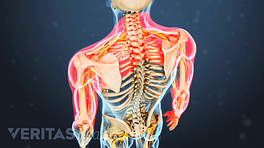Acute pain is pain that lasts for a specific time, has a specific cause, and has a protective function. Chronic pain is long-lasting and its cause may be elusive, making it harder to treat.
For the purpose of guiding treatment, doctors will usually categorize the pain as either acute or chronic.
Whereas the cause of chronic pain can be difficult to identify, acute pain is caused by a specific injury or condition.
In This Article:
- How to Understand Chronic Pain vs. Acute Pain
- Suffering and Chronic Pain
Acute vs. Chronic Pain
Acute pain is generally defined as being caused by an identifiable source that is associated with some type of tissue damage, inflammation or disease process. Acute pain has a relatively brief duration, usually a few days or weeks, and most often serves a protective function. For example:
- Wrist joint pain while unscrewing a jar top indicates that there is too much stress on the joint, so the person stops trying to unscrew the cap.
- A person who touches a hot stove feels pain and pulls his or her hand away to prevent a serious burn.
- A person recovering from an illness feels pain, signaling the need for rest.
Chronic pain is defined as pain that lasts beyond the expected period of healing. 1 Chronic Pain Rehabilitation. Cleveland Clinic. NONE. Available at http://my.clevelandclinic.org/services/rehabilitation-sports-therapy/specialty-therapy-services/chronic-pain-rehabilitation. Accessed April 4, 2015. Chronic pain is often described as pain lasting longer than 3 to 6 months, but this time period is a rule of thumb; normal healing time should be the primary consideration. For example:
- A mild wrist sprain normally heals within a week or two. If the wrist still hurts 4 to 6 weeks after the initial injury the pain may be considered chronic, and medical attention is recommended.
- Conversely, a person recovering from knee osteotomy surgery may need treatment for pain for several months, but this pain is considered acute because it is part of the normal healing process.
Chronic pain may be further classified by its source.
Sources of Chronic Pain
A person with chronic pain may have pain due to:
- A disease, such as ankylosing spondylitis or osteoarthritis
- Damage to the nervous system, such sciatic nerve irritation, that continues after the source of the irritation has been addressed
- A problem that is not physically identifiable. In these cases the source of the pain is unclear. This type of chronic pain has been assigned many different terms such as chronic benign pain, chronic cancer pain, chronic non-specific pain and others. Fibromyalgia is a good example of a type of chronic pain that does not have a well-understood cause
The source of chronic pain will affect how it is treated:
- When the source of the pain is understood, the physician will try to eliminate that source to the extent possible. For example, rheumatoid arthritis patients may be treated with disease modifying antirheumatic medications (DMARDs) or biologic drugs.
Learn more: Arthritis Treatment Options
- When the pain is the result of injury to the nervous system, a physician may recommend a treatment that interferes with the pain signals, such as medication or lidocaine patches.
- When the source of the pain is unclear, the treatment focuses more on reducing the sensation of pain rather than addressing the underlying cause of the pain. For example, painkillers and massage therapy may be recommended to address the ongoing pain.
Like acute pain, pain associated with chronic conditions—such as rheumatoid arthritis, osteoarthritis, ankylosing spondylitis and other types of arthritis—can serve a function. For example, arthritis pain that gets worse with certain types of activities can signal a body’s need for rest.
See Ankylosing Spondylitis Symptoms, Arthritis Treatment Options, and Arthritis Treatment Options.
- 1 Chronic Pain Rehabilitation. Cleveland Clinic. NONE. Available at http://my.clevelandclinic.org/services/rehabilitation-sports-therapy/specialty-therapy-services/chronic-pain-rehabilitation. Accessed April 4, 2015.




